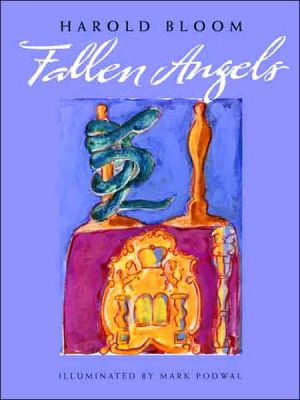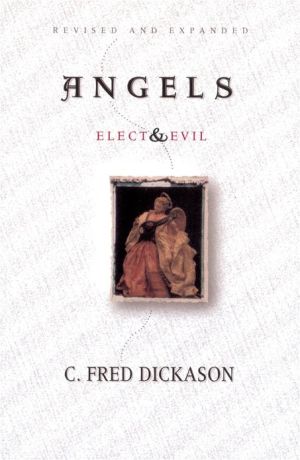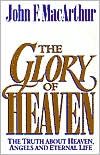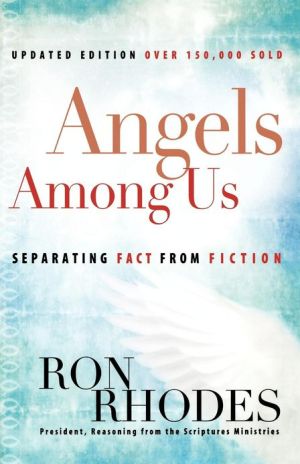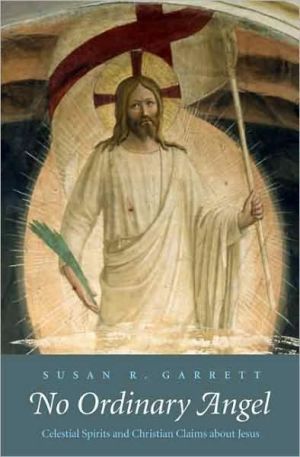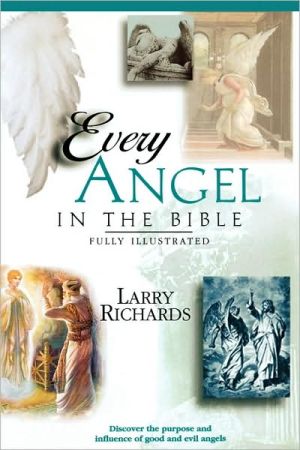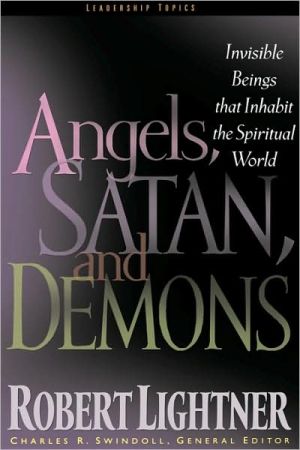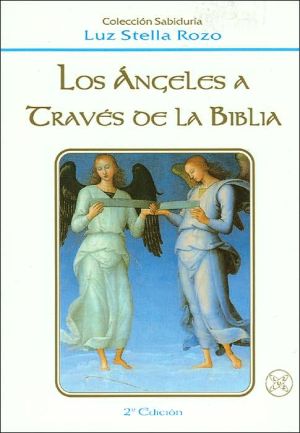Fallen Angels
In this lovely gift book published for the holiday season, Harold Bloom again combines his lifelong interests in religion and literature. He begins by observing our present-day obsession with angels, which reached its greatest intensity as the current millennium approached. For the most part, these popular angels are banal, even insipid. Bloom is especially concerned with a particular subspecies of angels: fallen angels. He proceeds to examine representations of fallen angels from...
Search in google:
Harold Bloom, our preeminent literary critic, essays to explain the meaning of angels in world literature David B. Levy - Library Journal The prolific Bloom (humanities, Yale Univ.; The Western Canon) adds to the popular literature on angels, taking the reader on a light jaunt through historical representations of fallen angels, from those in the Tanakh to those of Tony Kushner's Angels in America. Accompanying this wide-ranging narrative are a dozen-plus watercolors, line drawings, and illuminated letters. The book does not pretend to be a comprehensive, scholarly tractate on the subject. Had Bloom been writing from the rabbinic tradition, he would have more extensively explored encounters with angels in the oral law or in rabbinic works. Instead, he mostly relies on literary references and examines fallen angels from a historico-literary and theologico-literary perspective. It is with regards to theology that Bloom may be cited as not devoting enough attention to a crucial issue. Though he briefly acknowledges that "the Satans of the Four Gospels are essentially what we now term instances of anti-Semitism," this is an issue he fails to address adequately. Perhaps a book such as this, mass-marketed for the jolly holiday season, is not the place for such an investigation. For what it sets out to do, however, Bloom's book succeeds. A delightful read recommended for public libraries.
Fallen Angels \ \ By Harold Bloom \ Yale University Press \ Copyright © 2007 Harold Bloom\ All right reserved.\ ISBN: 978-0-300-12348-7 \ \ \ \ \ Chapter One \ For three thousand years we have been haunted by images of angels. This long literary tradition extends from ancient Persia through Judaism, Christianity, Islam, and the various American religions. With the approach of the millennium, our obsession with angels intensified. But these popular angels were benign, indeed banal, even insipid. The 1990s saw the publication of many books on angels-on contacting and communicating with guardian angels, on angelic intervention, healing, and medicine, on angelic numbers and oracle cards-there were even "angel kits" (one can only imagine). The Present Darkness (1986) and its sequel, Piercing the Darkness (1989), which depict the struggles between demons and angels in the fictional college town of Ashton, were among the biggest sellers in the so-called Christian fiction genre: The Present Darkness has sold in excess of 2.5 million copies. A Book of Angels, by Sophy Burnham, published by Ballantine Books in 1990, was a New York Times best seller and one of the books often credited with starting the publishing bonanza of angelology. According to the publisher, the book "tells not only the extraordinary true stories of present-day encounters with angels, but also traces the understanding and study of angels throughout history and in different cultures. What do angels look like? Whom do they choose to visit? Why do they appear more often to children than to adults? An eloquent report from the place where earth and heaven meet, A Book of Angels is a quest into mysteries and a song of praise to life." The popular Angelspeake: How to Talk with Your Angels (1995), by Barbara Mark and Trudy Griswold, offers a "practical" guide for readers. The decade saw, too, the release of any number of movies whose main characters were angels; to name just a handful, Wings of Desire (1988), The Prophecy (1995), Michael (1996), Meet Joe Black (1998), and Dogma (1999). There were also angel T-shirts, mugs, calendars, postcards, jewelry, and sunglasses. Nor, on evidence of a quick Amazon search, has the angel craze abated in any significant way since the passing of the millennial year. To cite just a few recent books: Contacting Your Spirit Guide (2005), Angels 101: An Introduction to Connecting, Working, and Healing with Angels (2006), and Angel Numbers (2005; a pocket guide to "angelic meanings of numbers from 0 to 999"). \ There are also popular obsessions with fallen angels, demons, and devils, who are only rarely insipid. The star figure among them, Satan, began as what we now would call "a literary character" long before his apotheosis in the Paradise Lost of John Milton. I had better explain precisely what I mean by that beginning, since so many people confuse problems of literary representation with the very different questions of belief and disbelief. One can provoke considerable abuse by the truthful observation that the Western worship of divine beings is grounded in several distinct but related instances of literary representation. The Yahweh of the J writer, first of Hebrew authors, is certainly an astonishing literary character, conceived with a shrewd mingling of high irony and authentic awe. The Gospel of Mark's Jesus may not be the first literary portrait of Mary's son, but certainly it has proved the most influential. And the Koran's Allah is palpably a literary monologist, since his voice speaks all of the book, in tonalities that convey a comprehensive personality.\ Demons belong to all ages and all cultures, but fallen angels and devils essentially emerge from a quasi-continuous series of religious traditions that commence with Zoroastrianism, the dominant world religion during the Persian empires, and pass from it to Exilic and post-Exilic Judaism. There is a very ambivalent transference of bad angels from later Judaism to early Christianity, and then a quite ambiguous transformation of the three earlier angelic traditions into Islam, difficult to trace precisely because Neoplatonic and Alexandrian systems like Hermetism get into the mix.\ To most of us, the fallen angel proper is Satan, or the Devil, whose early literary history is very much at variance with his ongoing status as a celebrity. The book of Job, a work of uncertain date, seems to me quite as surprising a presence in the canon of the Hebrew Bible as are Ecclesiastes and the Song of Songs. Job's book begins when an angel called the satan, who seems to be God's prosecuting attorney, or accuser of sin, enters the divine court and makes a wager with God. The satan is one of the "sons of God," in good standing, while the Hebrew word satan means an obstructer, someone who is more a blocking agent or stumbling block than an adversarial force. Neil Forsyth, whose book on Satan, The Old Enemy (1987), remains unsurpassed, points out that "the Greek for 'stumbling block' is skandalon, which gives us not only 'scandal' but also 'slander.'" This first or Jobean Satan appears to be God's CIA director and becomes very bad news for poor Job. Forsyth traces Satan's downward path through the book of the prophet Zechariah, where Yahweh reprimands Satan for an abuse of power but does not remove him from his office as Accuser.\ The Hebrew Bible thus has the word satan but absolutely does not have Satan himself-fallen angel, devil, and chief of demons. Satan proper, who became crucial to Christianity, was not a Jewish but a Persian idea, invented by Zoroaster (Zarathustra) more than a thousand years before the time of the historical Jesus. Demons, of course, are universal-every culture, each nation, all peoples had them from the start-yet Zoroaster went well beyond Iranian notions of demons when he fashioned Angra Mainyu, later to be called Ahriman, the Spirit of Evil. Energetic in evil, Ahriman was God's twin brother, which is distinctly not an idea that Christianity extended to its version of Ahriman, the New Testament's Satan. Who after all would have been the father who begot both God and Satan? There are esoteric traditions that make Satan Christ's twin brother; ultimately that is a return to Zoroaster's vision. Satan-the greatest blend of fallen angel, demon, and devil-disturbs all of us because we sense how intimate a relation we enjoy with him. The Romantics are frequently blamed for that enjoyment, but I think it is older than Romanticism and touches deep elements within us, though the Romantics, and Lord Byron in particular, can be credited for having enhanced these elements.\ I suspect that all of us, almost whoever we are, have richly ambiguous attitudes toward the idea of "fallen angels," and rather less so toward that of "devils," let alone "demons." We don't necessarily take it as an insult when someone says to us, "You devil you," or calls us "a devil of a fellow," or even "a she-devil." Sometimes we uneasily accept being called a "demon," particularly when the reference is to the intensity of our energies. Yet I don't know many, in literature or in life, who are not rather charmed by being described as "a fallen angel." "Fallen angels," though theologically identical with "devils" and sometimes with "demons," retain a pathos and a dignity and a curious glamour. Somehow the modifier does not cancel out the substantive; however fallen, they remain angels. T. S. Eliot tended to blame this upon John Milton, and once referred to Milton's Satan as a curly-haired Byronic hero. Though that was a silly description of Paradise Lost's tragic villain, it accurately reflected a cultural identification that persuaded the nineteenth century and still leads a kind of underground existence.\ George Gordon, Lord Byron, was and is the Fallen Angel proper. His various imitators, ranging from Oscar Wilde to Ernest Hemingway and Edna St. Vincent Millay, have never been able to displace him. The Brontë sisters, fiercely in love with the image of Byron, provided better imitations of him in Emily's Heathcliff and Charlotte's Rochester. English rock stars, not always consciously, frequently are parodies of the noble Lord Byron, and so of course are hosts of film stars. Byron was superbly ambiguous in his narcissism: incestuous, sadomasochistic, homoerotic, and famously fatal to women. His notorious charisma emanated from his self-identification as a fallen angel: he is Manfred, Cain, Lara, Childe Harold-all versions of the Miltonic Satan. Byron's enormous vogue throughout Europe and America was vastly stimulated by his heroic death at thirty-six, attempting to lead Greek brigands in their revolt against the Turks. But his death, life, and poems together probably did not match in notoriety his popular role as the most seductive of all fallen angels.\ In his wonderful satire The Vision of Judgement, Byron gave an engaging portrait of Satan:\ But bringing up the rear of this bright host A Spirit of a different aspect waved His wings, like thunder-clouds above some coast Whose barren beach with frequent wrecks is paved- His brow was like the Deep when tempest-toss'd- Fierce and unfathomable thoughts engraved Eternal wrath on his immortal face- And where he gazed a gloom pervaded Space.\ That is clearly a rather cheerless but not undignified fellow, and, like most Satanic representations in Byron's projects, Byron himself. His devils are not jolly, like Mephistopheles in Marlowe's Dr. Faustus and Goethe's Faust, but they are always noble, like Lord Byron, who never allows his readers to forget the high birth of their poet. Demons and devils generally are not exactly noble, but fallen angels are almost never vulgar or plebeian. Benign angels all too often seem to confuse their innocence with ignorance, but fallen angels always seem to have enjoyed an old-fashioned education and a proper upbringing. Byron was very much a Regency dandy and snob, and he may have inspired the visual tradition in which fallen angels tend to outdress the unfallen, who are frequently naked anyway.\ There is, as I keep noting, a fundamental duality of response that most of us experience in regard to all three of those dangerous entities: fallen angels, demons, and devils. They provoke in us both ambivalence and a certain ambiguity of affect. This mingled delight and horror is more ancient than Romanticism, and more universal than Western tradition. Ibsen, himself at least half a troll, gave us grand trolls in Brand, Hedda Gabler, Solness the Master Builder, and several more, and a half-troll in Peer Gynt. Rather reluctantly, Ibsen followed Shakespeare, whose Puck overtly is an English troll but whose great villains-Iago, Macbeth, the Edmund of King Lear-are more demonic and trollish than at first seems wholly compatible with being human. But that is part of Shakespeare's invention of the human, to teach us the extent to which many of us are more fallen angels than devils. Hamlet, who is his own Falstaff, is also to a surprising degree his own Iago, and Hamlet has become a paradigm for all of us. Is Hamlet a fallen angel? Are we fallen angels? Both questions could be dismissed as nonsense, yet they have their reverberations.\ Presumably the unfallen angels spoke (and speak) Hebrew, since Talmud and Kabbalah alike insist that God spoke Hebrew in the act of Creation, and what language would he have taught angels other than Hebrew? Fallen angels notoriously are polyglot, and sometimes they have turned into human beings. We know that Enoch began as a mortal and then was transmogrified into the great angel Metatron, who in Gnostic and Kabbalistic traditions was known as the lesser Yahweh, more than an angel and almost co-ruler with God. Our father Jacob became Uriel, Emerson's favorite angel, and then the angel Israel. The fierce prophet opposite: Unfallen Angels Spoke (and Speak) Hebrew Elijah went up to heaven in a chariot of fire, and on arrival metamorphosed into the angel Sandalphon. Dissident Franciscans proclaimed that their great founder, Francis of Assisi, was no mere saint but the angel Rhamiel. The process goes both ways, and always takes us back to Adam, perhaps higher than the angels when he began, certainly lower than the angels when he fell, but where does he rank in comparison to fallen angels?\ The center of any discussion of fallen angels has to be Adam, who seems to me a far greater fallen angel than Satan. Even as an imaginative idea, angels matter only if we matter, and we are (or were) Adam. Lest feminists disagree, I remind all of us that Talmud and Kabbalah alike argue that Adam originally was androgynous, as was his prototype, God. Adam, Enoch, Metatron, opposite: Elijah's Metamorphosis and God may be the same figure, a formulation that seems purely Mormon or Gnostic Kabbalistic but that Moshe Idel convincingly traces back to very early speculations, perhaps to an archaic Judaism itself, before even the J writer, or Yahwist, retold the story of Adam and Eve more or less as we have it since. The apotheosis of Enoch into Metatron is a return of Adam, interpreted by Kabbalah as the original God-Man, a fusion beyond the limits of our imaginations. Certain Gnostics spoke of the Angel Christ as being the restored Adam, a vision that opposes Saint Paul, since the Angel Christ is not a Second Adam but the true form of the First Adam.\ Again, I am less concerned here with the angel Adam than with his fallen status. We can be fallen angels without being demons or devils, and I therefore want to see what light we can gain by recognizing this. Angels-unfallen or fallen-make sense to me only if they represent something that was ours and that we have the potential to become again. The people we call schizophrenics once were called angels; perhaps they still should be, which certainly does not imply that mental illness is a myth, or that cures for such illness ought not to be found. Otherness is the essence of the angels; but then it is our essence also. That does not mean that the angels are our otherness, or that we are theirs. Rather, they manifest an otherness or potential akin to our own, neither better nor worse but only gradated to a different scale. The Vatican Museum collects angels; piety and self-interest join in that concern. What the Vatican and the American Religion alike would not accept is my increasing conviction that all angels, by now, necessarily are fallen angels, from the perspective of the human, which is the Shakespearean perspective. Every angel is terrifying, wrote the poet Rilke, who had not confronted a screen upon which John Travolta cavorted as an angel.\ What can it mean to contend that no distinction is still possible between unfallen and fallen angels? We are fallen Adam (or fallen Eve and Adam, if you prefer), but we no longer are fallen in the Augustinian or traditional Christian sense. As Kafka prophesied, our one authentic sin is impatience: that is why we are forgetting how to read. Impatience increasingly is a visual obsession; we want to see a thing instantly and then forget it. Deep reading is not like that; reading requires patience and remembering. A visual culture cannot distinguish between fallen and unfallen angels, since we cannot see either and are forgetting how to read ourselves, which means that we can see images of others, but cannot really see either others or ourselves.\ Momentarily set aside your probable skepticism, and assume with me that we are fallen angels, a larger category in my view than devils or demons. In a popular reduction, we frequently feel that little children are angels, reflecting Victorian conventions. Since we grow up, we fall, or, more simply, are fallen. But that is a little too simple, since our current American obsession with angels is rather more childish than childlike. The ancient angels did not fall because they grew up, though that is certainly one version of the Satanic argument. C. S. Lewis, eminent defender of orthodoxy, argued just the reverse: the angels who fell were those who failed to mature. William Empson, in his Milton's God, disagreed with the angelic C. S. Lewis by observing that God himself provoked Satan's rebellion. Saint Augustine, alas, has to be our ultimate authority upon the Fall: The City of God, Augustine's masterwork, says that Satan and his cohorts fell through pride, which seems to me very different from immaturity.\ (Continues...)\ \ \ \ \ Excerpted from Fallen Angels by Harold Bloom Copyright © 2007 by Harold Bloom. Excerpted by permission.\ All rights reserved. No part of this excerpt may be reproduced or reprinted without permission in writing from the publisher.\ Excerpts are provided by Dial-A-Book Inc. solely for the personal use of visitors to this web site. \ \
Contents List of Illuminations....................viiFallen Angels....................1Illuminations The Devil Proper....................8Unfallen Angels Spoke (and Speak) Hebrew....................19Elijah's Metamorphosis....................21Demons....................30Lilith....................32Devils....................36Our Fall....................42Good and Evil....................52Metatron....................54Sammael, the Angel of Death....................57Sitra Ahra, or "The Other Side"....................62Angelicism....................68Fallen Angels....................70
\ Library JournalThe prolific Bloom (humanities, Yale Univ.; The Western Canon) adds to the popular literature on angels, taking the reader on a light jaunt through historical representations of fallen angels, from those in the Tanakh to those of Tony Kushner's Angels in America. Accompanying this wide-ranging narrative are a dozen-plus watercolors, line drawings, and illuminated letters. The book does not pretend to be a comprehensive, scholarly tractate on the subject. Had Bloom been writing from the rabbinic tradition, he would have more extensively explored encounters with angels in the oral law or in rabbinic works. Instead, he mostly relies on literary references and examines fallen angels from a historico-literary and theologico-literary perspective. It is with regards to theology that Bloom may be cited as not devoting enough attention to a crucial issue. Though he briefly acknowledges that "the Satans of the Four Gospels are essentially what we now term instances of anti-Semitism," this is an issue he fails to address adequately. Perhaps a book such as this, mass-marketed for the jolly holiday season, is not the place for such an investigation. For what it sets out to do, however, Bloom's book succeeds. A delightful read recommended for public libraries.\ —David B. Levy\ \ \
